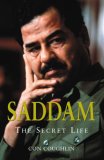Summary | Excerpt | Reviews | Readalikes | Genres & Themes | Author Bio

King of Terror
by Con CoughlinChapter One
The Orphan
The young Saddam Hussein had a harsh and deprived childhood. The man who was to become one of the most powerful Arab leaders of modern times came from an impoverished village situated on the banks of the Tigris River on the outskirts of the provincial town of Tikrit. He was born into a poor family in one of the country's most inhospitable regions. At an early age Saddam was orphaned and sent to live with relatives, who oversaw his upbringing and education. No profound knowledge of psychology is required to estimate the effect these circumstances had upon the child's development. As with Hitler and Stalin, those two great tyrants of the twentieth century, both of whom overcame their less than auspicious starts in life to take absolute control of their respective nations, Saddam was to rise above the disadvantages of his childhood to become the undisputed master of Iraq. The shame of his humble origins was to become the driving force of his ambition, while the deep sense of insecurity that he developed as a consequence of his peripatetic childhood left him pathologically incapable in later life of trusting anyone -- including his immediate family. Given the disadvantages of his birth, Saddam deserves credit for overcoming these seemingly insurmountable social obstacles to reach the pinnacle of Iraq's political pyramid.
Saddam was born in the village of Al-Ouja, which means "the turning," and is so named because of its location on a sharp bend in the Tigris River eight kilometers south of Tikrit, in north-central Iraq. The village was then a collection of mudhuts and houses and the inhabitants lived in conditions of abject poverty. Amenities such as running water, electricity, and paved roads were unheard of, and although there were a number of wealthy landowners in the region, the village itself was barren. Infant mortality was high, and survival for many was a full-time occupation. The big estates, situated in the Fertile Crescent, produced a variety of crops such as rice, grain, vegetables, dates, and grapes, and their owners, who resided either in nearby Tikrit or the ancient metropolis of Baghdad, were held in high esteem within Iraqi society. In what was essentially a feudal society, the function of the impoverished inhabitants of Al-Ouja was to provide a fund of cheap labor to work as farmhands on the estates or as domestic servants in Tikrit. There were no schools at Al-Ouja. The wealthier parents sent their children to school in Tikrit, but the majority could not afford it, and their barefoot children were left to their own devices.
While most of the inhabitants were gainfully employed in these mundane pursuits there were some who preferred to sustain themselves through illicit activities such as theft, piracy, and smuggling. Historically Al-Ouja was known as a haven for bandits who would earn their keep by looting the doba, the small, flat-bottomed barges that transported goods between Mosul and Baghdad along the Tigris, one of Iraq's most important trade arteries. The looters were particularly active in the summertime when they could more easily go about their business from their vantage point on the bend in the river where the passage of the boats was of necessity slow, and where the doba would sometimes become stuck on the shallow banks. Poaching was another popular activity, and some of the villagers felt no compunction about helping themselves to chickens and fresh produce from the neighboring estates.
Officially, Saddam was born on April 28, 1937, and, to lend the date authenticity, in 1980 Saddam made it a national holiday. Given the primitive nature of Iraqi society at the time of his birth, it is, perhaps, hardly surprising that this date has been challenged on several occasions, with some of his contemporaries arguing that he was born a good couple of years earlier, in 1935, while other commentators have claimed that he was born as late as 1939. This might be explained by the fact that the whole process for registering births, marriages, and deaths was exceedingly primitive. At this time it was the custom for the authorities to give all peasant children the nominal birth date of July 1; it was only the year that they attempted to get right. This would certainly explain why a certificate presented in one of Saddam's official biographies gives July 1, 1939, as the date of his birth. In fact, Saddam acquired his official birth date from his friend and future co-conspirator, Abdul Karim al-Shaikhly, who came from a well-established Baghdad family and so had the advantage of possessing an authentic birth date. "Saddam was always jealous of Karim for knowing his own birthday. So Saddam simply copied it for himself." Not content with stealing someone else's birthday, it is now generally accepted that Saddam also changed his year of birth to portray himself as being older than he actually was during his meteoric ascent through the ranks of the Baath Party. This is explained by his marriage to his first wife, Sajida, who was born in 1937. It is frowned upon in Arab society for a man to marry a woman older than himself, and Saddam appears to have amended his year of birth to that of his wife. The fact that Saddam cannot even be clear about his precise date of birth says a great about his inner psychology.
The foregoing is excerpted from Saddam: King of Terror by Con Coughlin. All rights reserved. No part of this book may be used or reproduced without written permission from HarperCollins Publishers, 10 East 53rd Street, New York, NY 10022.






Your guide toexceptional books
BookBrowse seeks out and recommends the best in contemporary fiction and nonfiction—books that not only engage and entertain but also deepen our understanding of ourselves and the world around us.